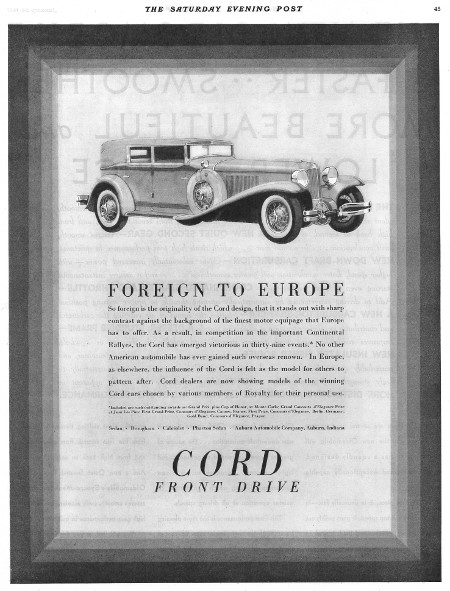By Robert Tate, Automotive Historian and Researcher
Images courtesy of the National Automotive History Collection
Posted: 10.24.2016

One of the most distinguished and great looking automobiles of all times would be the famous Cord models that were introduced to the public during the 1930s. Some people have even referred to them as the most admired and the greatest looking automobile designs of all times.

The first two images that is a part of this story are advertising pieces highlighting Cord’s great designs from the early 1930s.

One of the most intriguing Cord models was the 1931 La Grande Boat Tail Speedster. The pictured model shown is from the New York auto show. Later, the model was reportedly purchased by Mr. Paul Berns, the husband of the late movie actress Jean Harlow. This remarkable example of automotive style was designed by Mr. Phil Wright.
Other examples of great looking Cord models include the 1936-37 Cords designed by the late and legendary designer Gordon M. Buehrig. Mr. Buehrig was still a young man when he was asked to come up with the Cord design, however he was no newcomer to the automobile styling industry. He had been chief body designer for Duesenberg for four years and had been with General Motors, Budd, Packard and Stutz just to name a few. Buehrig is most remembered for his trademark designs of the 1936-1937 Cord models which many people still talk about today.
Of the 1936-37 Cord designs, Buehrig had said, “We thought we had something different but not ugly as so many things turn out when a designer tries to be different.”

To start this great journey on the popular Cord models you have to go back in time to the early stages when 100 scale Cord models were completed and introduced to the public at the 1935 Auto Show in New York City. The new designs offered the public a streamlined rear-end design along with a closed hood, retractable headlamps and a new style that most consumers thoroughly had enjoyed.
It was an automotive design that some people called timeless. During the early developments, designers used the term “Baby Duesenberg” to describe the prototype for the 1936 Cords. The downsized Duesenberg project was started in November of 1933, however, the design assignment was delayed because Gordon Buehrig was assigned to lead the 1935 Auburn program.
As the journey for the Cord models continued, the vehicles offered consumers an aircraft inspired instrument design panel that was very well engineered for the driver along with a great looking interior. Cord's significant innovation was also exhibited by the introduction of front-wheel drive.

The 1937 Cord models were much improved over the 1936 cars and they even made a mark for themselves in numerous competitive events throughout the year. On Jan. 7, 1937, a supercharged 812 Cord achieved best in class performance in the “Gilmore-Yosemite Economy Run” while competing against a Chrysler Airflow.
The 1937 Cord models were great looking designs and the average cost for a Cord at the time was about $ 2,960. Many passengers at the time were also surprised at the roomy comfort of the Cord.
In spite of the low overall height, the Cord models had offered more head room and more leg room than most automobiles during the 1930s. Auto-Car publication said this about the Cord models for 1936, “Probably, for both its appearance and its general design, the American front-wheel-drive Cord is the most unorthodox car in the world today that is produced on a serious quantity basis and sold in this country.”
Unfortunately, financial problems plagued the Auburn Automobile Company along with the Cord Corporation. Not long after the 1937 models were introduced, manufacturing of the Cord became unsustainable. On August 21, 1937, the last Cord, which was an 812, came off the line at the Auburn factory in Connersville, Ind., which today has become a significant historical note in our automotive history books.

Shortly after production had ended on the Cord, a brief statement appeared in the Automobile Trade Journal, Oct. 1937, “Manufacture of Auburn, Cord and Duesenberg automobiles will be discontinued by the Cord Corporation informed Wall Street sources insist.”
Unfortunately, Cord had ended its manufacturing process, however the Cord name plate will always be best remembered for its great automobile styling that most Americans enjoyed.



